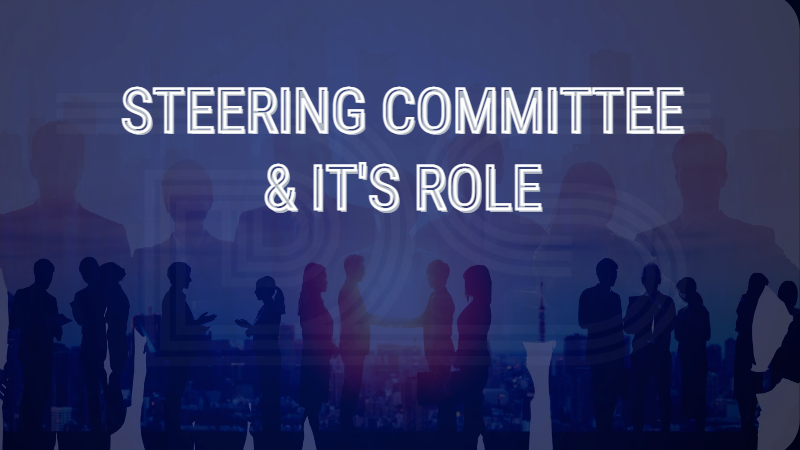
by admin | Jun 4, 2023 | General
Project management may be challenging. Addressing changing business demands, allocating limited resources, and managing team workloads can all result in dealing with complicated project management aspects on a day-to-day basis. However, having high-level assistance and guidance can be a lifesaver. Steering committees accomplish precisely that. Project management steering committees give administrative assistance and troubleshoot issues to keep projects on schedule to achieve their objectives.

Steering Committee
Steering Committee
A steering committee is an advisory body of important stakeholders overseeing and supporting a project to ensure its success. Project steering committees are also known as stakeholder boards, senior leadership teams, and project working groups. They manage projects from beginning to end, offering direction and assistance throughout the project’s lifecycle.
A steering committee’s primary concern is the organization’s direction, scope, budget, timeline, and techniques. Steering committees will meet regularly to discuss these issues to identify where they are and where they want to go to stay on track.

Project Steering Committee
Project Steering Committee
A steering committee may also be a group working together on initiatives. In this case, steering committees assist project managers in ensuring that projects are aligned with business objectives. They identify and manage risks, maintain project quality, and track progress and timeframes. In addition, the committee can approve changes to the project scope, budget, and strategy.
A project steering committee is a part of a larger organization for project governance. Companies that plan major projects that need collaboration across departments and include multiple stakeholders gain from a steering committee that can direct project management. The committee supervises the team’s progress toward fulfilling benchmarks and goals in this role.
The committee is in charge of project management, financial analysis, and recognizing changes that influence the project’s original scope. Furthermore, the project steering committee ensures that all points of view are heard and that any problems between stakeholders or departments are resolved.
Role of a Steering Committee
A steering committee can accomplish its core goal by utilizing a range of group and individual functions. When a steering committee gives advice and guarantees that items are delivered on time and in good condition, a company may reap significant benefits from its project successes. Some of the most important group-based steering committee positions that influence a business’s and consumers’ satisfaction with a product include:
- Providing input on the growth or development of a business or initiative.
- Addressing concerns and offering guidance on budgeting, marketing, recruiting, and other financial issues.
- Identifying the outcomes or objectives that the project must achieve.
- Prioritize the steps and objectives that must be completed to meet the project’s objectives.
- Assisting in the formulation of business-related policies, processes, and guidelines.
- Identifying, monitoring, and eliminating potential operational risks.
- Setting project deadlines or timelines and keeping track of progress.
- Monitoring the final work’s quality.
- Making plans for how a client or consumer will react to a product or service.
- Analyzing and discussing changes that have occurred or will occur to guarantee the project’s success.
- In the workplace, encouraging team members to collaborate.
- Where relevant, providing further insights on business or project concerns.
Members of the steering committee generally do not work on the project directly; nevertheless, committee members may perform various tasks individually to help assure the project’s success. Therefore, individual steering committee members should understand and strive to improve the strategies used to achieve project goals, be genuinely interested in the project and its outcome, promote the project whenever possible, and maintain a broad understanding of project management concerns, in addition to attending team meetings.
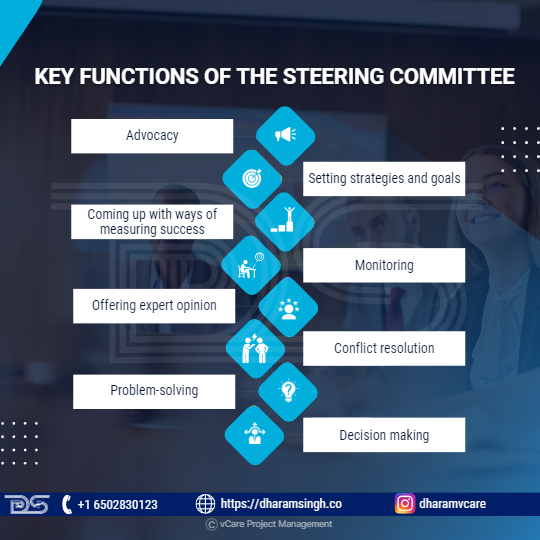
Key Functions of The Steering Committee
A steering committee is an advisory committee made up of various stakeholders and firm officials. They assist in making choices on various initiatives, with members directly interacting with project managers. Here are some of the key functions of the Steering Committee:
- Advocacy
A steering committee advocates for the organization’s varied goals and programs. Remember that it is generally composed of top management and specialists.
- Setting strategies and goals.
Steering committees develop strategic directions for initiatives. They also provide advice and opinions on budgeting, assets, money, time, facilities, marketing, and hiring. Goals and project scope are established as part of their employment.
- Coming up with ways of measuring success
There are several metrics for measuring performance. The steering committee is in charge of establishing how a product’s success is measured.
- Monitoring
The steering committee serves as an advisory body as well as a monitoring body. It ensures that projects fulfill the necessary quality standards and monitors any changes. It also keeps track of project processes and plans, which is critical to project success. The committee also analyzes and monitors project or company hazards before devising solutions to mitigate them.
- Offering expert opinion
The steering committee comprises experts who provide expert opinions on various issues concerning projects or the entire business. Their involvement is generally required, especially while working on a complex project.
- Conflict resolution
Disagreements are normal, mainly while working on a specific project. However, to ensure that issues do not disrupt the overall project, these committees resolve disputes between stakeholders, giving them more time to focus on what is best.
- Problem-solving
One of the functions of any advisory body is to discover solutions to problems the organization may be experiencing. It can generate various problem-solving ideas due to the experts on the strategy committee.
- Decision making
Although the steering committee’s primary function is to provide counsel, it also participates in decision-making. For example, it can analyze, accept, or reject project plans or recommend revisions to the supplied plans based on the members’ feedback.
The committee also engages in role allocation because its members can appoint project managers and other professionals to complete assigned tasks.
Ways to prepare for the project steering committee meeting
Important information and documents must be communicated with all steering committee members before the planned meeting, including:
- Meeting agenda
- Minutes of the previous steering committee meeting
- Project progress report from the project manager
Certain team members should be in charge of creating steering committee meeting documents and scheduling meetings. The steering committee is led by a chairperson who runs the meeting according to the agenda. They also ensure that all committee members express their viewpoints and ideas.
A basic meeting agenda would include the following:
- Recognizing and distributing the previous steering committee meeting minutes with other committee members.
- Conduct a thorough review of action items decided at previous sessions.
- Analyze the project status report filed by the project manager.
- Have a thorough discussion about any additional issues of concern or project requests.
- Select a date, time, and location for the next steering committee meeting.

Steering committee Best Practices For Project Success
Steering committee best practices for project success
Consider the following steering committee best practices for project success, whether you hold your meeting online or in person:
- Allow adequate time for the project team and committee members to prepare.
- Focus on the most important project KPIs and milestones and deliver them to the committee members in a format that everyone can agree on, such as a presentation, report, or infographic.
- Present project facts that are factual, contextual, and relevant. Share any inconsistencies or difficulties as soon as possible before they become significant issues.
- Schedule meetings in advance and automate meeting alerts to go out a week and a day ahead.
- Ensure comprehensive documentation of all meeting discussions and distribute it to committee members before the next meeting.
- Maintain the project charter and refer to it whenever there is doubt about authority, accountability, or strategic direction.

Challenges for Steering Committees
Challenges for Steering Committees
Because project management steering committees are comprised of employees from various backgrounds and functions, they will almost always experience certain challenges. These are some examples:
- Conflicting interests:As the committee includes cross-functional representatives, they will frequently have opposing ideas and interests. People think differently, which may be shown in their behavior, activities, and perspectives.
- Slow decision-making:Team decision-making is typically slower than individual decision-making.
- Lack of clarity in roles:Many committee members may need to know their individual or team responsibilities. A clearly defined charter for the steering committee ensures transparency and clarity about their duties in the project.
Final Thoughts
Every organization needs a Project Steering Committee to lead its transformation initiatives, beginning with a contemporary approach to project management. It may be instantly productive by initiating the process of managing project priorities. Steering committees are extremely crucial in efficient project management. They add value by keeping projects on pace, reducing risks, and resolving problems. When creating one, it is essential to evaluate the overall composition.
The steering committee plays a crucial role in project management that should be considered. The steering committee is the project’s administrator. This functionality does not exonerate the project of responsibility. On the contrary, this role necessitates that the steering committee participates in the project and not simply monitors the project group’s performance from the sidelines. This move will strain the steering committee’s multiple tasks and the time spent on the project.
Feel free to check out my discussion on this topic with Justin Buckwalter in YouTube
For any questions related to your Project Management career, training, and certifications, you can book an obligation free 15 minutes session with me by visiting talktodharam.com
You can subscribe to the vCare Project Management YouTube Channel to catch future videos of our Q&A series and certification success stories: https://bit.ly/2YF0wJl
You can subscribe to and follow my podcasts and interviews with Project Management Experts on YouTube at https://bit.ly/2NDY8wd

by DharamCW | May 7, 2023 | General
The project management office (PMO) is increasingly evolving from an administrative role to one that is strategic and more closely connected with business drivers. As a result, the PMO plays an important role in generating corporate value as the pace of business rises along with the expectation of faster returns on investment.
Traditional administrative PMOs fall short of meeting this need. Therefore, a mindset change and a reinvented project delivery capability that is both commercially astute and agile are required. Furthermore, such a PMO must comprehend and implement the plan.
In this article, we’ll look at the factors driving the shift to strategic project management offices (SPMO), also known as Enterprise PMO or EPMO, the essential features of a value-adding PMO, and game changer ideas to help you alter your PMO and improve its profile in your business.

What is Strategic PMO (SPMO)?
Strategic PMO (SPMO)
A Strategic PMO is a project-centric business department that should be structured and managed like other business departments – with enterprise leadership setting goals and objectives that assist the organization in thriving. The demands of individual organizations will lead to variations in what it means in specific terms. Still, we can expect a focus on the following areas:
- Portfolio management – Generation of ideas, selection, execution, and realization of benefits. Portfolio Management is a huge area, and organizations will adapt to it as it becomes increasingly crucial.
- Financial management – The PMO, closely linked to portfolio management, must be accountable for ensuring that project investments are acceptable and fit with business goals. The PMO must also guarantee competent budget management during project execution. Furthermore, the PMO should be held accountable for monitoring and tracking the benefit realization tasks of the business units.
- Enterprise-wide project-related processes and approaches Strategic risk management (i.e., managing the portfolio’s organizational risk exposure, proactive risk selection to match organizational tolerance, and so on), integration of finance and benefits, consistent quality standards, and so on.

Focus areas of Strategic PMO
- Proactive resource management – Capacity and capability planning, skills inventory management, and so on – ensuring that the project execution functions have the appropriate people with the right skills at the right time.
- Strategic partner – This borders on cultural change, creating the PMO as an independent and impartial consultant to the organization on project execution. PMOs, like IT, must demonstrate that they are business leaders supporting the organization’s work rather than a tactical execution-only function.
Different levels of PMO strategic alignment
Within an organization, a PMO can function at three stages of ‘Strategic’ maturity:

Different levels of PMO strategic alignment
- Strategy Creation – Strategy Creation entails assisting organizations in determining which strategic options to pursue (and then translating them into projects – Strategy Delivery – and managing their success – Strategy Management). It is unusual for a PMO to achieve this level of trust and influence inside an organization. Still, it is the (possible) future for the enterprise PMO that is effectively embedded within an organization and fortunate with the right sponsorship.
- Strategy Delivery – Strategy Delivery is the process through which the PMO turns important strategy objectives into new projects to be added to the portfolio (and perhaps to remove some from the portfolio if such objectives have changed). The ‘Strategy Supervision’ capability backs up this ‘Strategy Delivery’ capability. The PMO may also take direct responsibility for the execution of large and complex programs (or projects) that are specifically critical to a key strategic effort, such as relocation activities.
- Strategy Supervision – Strategy Supervision of strategic intents through project ownership, each of which should directly or indirectly link to a strategic intention of the overall organization. ‘Strategy Supervision’ is where the PMO acts as the Executive’s governing and advisory body by:
- Validating that all projects undertaken correspond to one or more strategic initiatives.
- Monitoring the current and right alignment of projects and strategy.
- Making stall-and-kill recommendations for initiatives no longer correspond with current corporate strategic thinking.
Five Steps to Creating the Strategic Enterprise Project Management Office (SPMO)
Today’s organizations recognize that fewer and fewer initiatives are self-contained inside individual departments and increasingly straddle multiple business functions. Project management offices (PMOs) have traditionally been connected with IT, partly due to technology’s role in all projects. However, with technology increasingly transitioning to contribute to those business transformation initiatives, keeping the PMO as an IT role is ineffective.
The appropriate response to this trend is a single, enterprise-wide EPMO. Many firms using EPMOs, however, fail to perceive an increase in project execution speed. In addition, here are the five key steps to achieving long-term EPMO success:

Five Steps to Creating SPMO
- Define the company’s goal.
- Create appropriate leadership and accountability structures.
- Communicate the purpose, responsibilities, and alignment.
- Respond to measurements and outcomes.
- Create a road map for actual evolution into a business function.
The Rise of the Strategic PMO
The strategic PMO may play a crucial role as a custodian and evangelist for business benefits realization, giving important information to the Executive on which projects deliver value across the organization. In addition, the insights provided by the SPMO may help with crucial decisions like which initiatives to fund, which projects to kill, or re-prioritizing or re-balancing work portfolios to reflect changing business or market conditions.
Not all PMOs must be strategic in character. For example, a PMO embedded within a project or program might focus on the project’s day-to-day resource management and administrative needs. However, the decision to start the project should have been taken at a strategic level. From the start, the project-level PMO should have been aligned with the Strategic PMO’s reporting and governance structure. The SPMO should be able to make micro and macro business choices based on accurate and timely project data flow up into the program and, eventually, portfolio level.
The Strategic PMO plays a key role in championing and driving business value for the organization and being an effective change enabler. Here are the five major game changers that will propel the PMO and project organization to the next level.

5 Major game changers that will propel the PMO and project organization to the next level
- Demonstrating Project Leadership and Vision
- The Importance of Realistic Planning
- A Culture of Disciplined Execution
- Effective Stakeholder and Change Management
- Creating a “Value Lens” for Managing Enterprise Investment
The strategic project management office is critical to increasing project maturity and optimizing the organization’s business return on project investment. People, processes, data, and technologies must all be prioritized to achieve this objective. Project management is a multifaceted endeavor that is both an art and a science.
Leveraging the future of PMO to drive new strategic opportunities
In recent years, businesses have been subjected to a slew of external forces, the most significant of which has been Covid-19. These disruptors have caused firms to adapt, whether to work around obstacles, shift to new working methods, or adapt to Industry 4.0. All of these variables influence organizational complexity, both strategically and operationally. Businesses must not only respond proactively to all of this complexity; they must also prosper while operating in a resource-constrained environment. As a result, today, more than ever, the PMO’s ability to efficiently deliver projects and transform organizations of all kinds and across many locations is critical to achieving their goals.
Projects must be completed at scale to create transformation for a company effectively. A McKinsey & Company study of over 5000 large-scale projects discovered that 56% generated less value than planned, 45% went over budget, and 17% were so disastrous that the organization’s survival was threatened. This study highlights the need to make adequate efforts to select PMOs who can adapt to the future of work.
Historically, PMOs have been viewed as lacking a clear identity or purpose within an organization; however, the future-state PMO is an enabler of business value creation, collaborating with business leaders to provide a clear and achievable roadmap while making the best use of the organization’s limited resources.
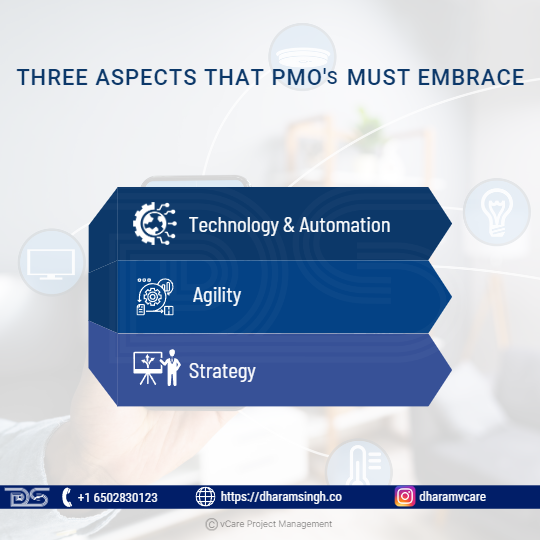
3 Aspects that PMOs must embrace
PMOs must also adjust to the new normal and growing business demands. The three areas described below represent the fundamental features that PMOs of the present and future must embrace to manage change effectively.
- Technology & Automation
Because Covid-19 has accelerated the way we utilize technology in our daily work, technology is expected to be front and center, enabling PMOs to deliver more successfully. To effectively adapt to new methods of working and build a “single source of truth,” advanced technologies and cloud-based solutions will be required. This technology jump is critical for borderless operations in which progress and transparent communication must be readily available and updated in real-time to allow for swift decision-making.
In the future world, both artificial intelligence and machine learning will be important facilitators of automating PMO procedures, delivering superior insights, and allowing teams to spend less time on manual transactional processing and more time generating value for projects. For example, project planning is often based on data collection, industry benchmarking, and using the experience of project managers. However, according to PMI – AI Innovators, there is still a significant inefficiency in project management, with around 1/3 of traditional project management activities requiring one or more days of manually collating reports. Using IoT and big data to automate various tedious processes allows the PMO to create more realistic and effective timetables and spot potential disruptors.
However, it is unlikely that technology will completely replace project managers, with the PMI forecasting that businesses will require over 88 million project managers by 2027. As a result, PMs will be expected to improve their competencies and fully utilize the available technologies.
PMOs will be required to lead by example in their automation projects, advocating new methods of working with their collaborative organization in the future. As a result, the paradigm of efficiently providing workstreams may evolve, driving firms to become more digital.
- Agility
With an increased level of complexity for transformation and multiple stakeholders to handle, projects may need to adapt and pivot in other ways than originally planned. Changes in priorities (39%) and objectives (37%) and the inability to adapt are the two leading reasons for project failure, according to PMI.
As a result, PMOs that can be responsive to change needs continually are critical to fulfilling project milestones, which might mean the difference between being an industry leader or a laggard. An agile PMO’s guiding principles are as follows:
- Decentralization of planning and decision-making
- Agile resource allocation and reallocation
- Workflows that are effective for continuous project advancement
An agile PMO may demonstrate agility by altering priorities and reallocating resources to achieve new objectives while transitioning seamlessly from reorganization to continuous delivery. Furthermore, decisions are decentralized, allowing faster response rates for recognizing and reducing hazards. Finally, communication is critical, with fewer layers of approval, and output is assessed by how much work can be done in a particular sprint.
However, merely establishing an agile PMO will only solve some difficulties; 47% of agile projects are late, have budget overruns, or result in dissatisfied consumers. A cultural revolution is required to fully realize agile’s potential, beginning with the leadership team and spreading across the firm.
As a result, the PMO cannot only act as an intermediary but also as a business partner, working alongside the leadership team and the rest of the organization. Team members must be self-sufficient, accountable, and have complete insight into project progress and data.
- Strategy
The PMO’s role must evolve from a team offering mere assurance to becoming a strategic partner with a vested interest in aligning with the organization’s ability to carry out its plan. As a result, the team is expected to have stronger strategic oversight of all work streams to deliver value throughout the project.
PMOs will be required to go beyond task completion and monitoring to include:
- Portfolio planning entails generating ideas for the activities required to capitalize on the opportunity.
- Project prioritizing entails determining the most effective timeframe and budgeting by the company’s demands.
- Capacity planning entails assigning the appropriate skills and resources to each work team.
- Resilience planning entails anticipating future obstacles and reducing interruptions.
- The strategic partnership is a cultural transformation in management and the PMO. The PMO is viewed as a business leader and adviser with a stake in the organization’s goals.
The key to success is consistent stakeholder engagement, with the PMO and business leaders holding frequent strategic discussions to monitor and coordinate company strategy and broad strategic objectives. This consistency will build a collaborative strategic management process and a fluid communication channel to adjust quickly and efficiently.
The future PMO will be more strategic and intricate in character than conventional models, emphasizing driving decision-making, execution, and outcomes while becoming more decentralized to interact with each workstream to achieve one common goal efficiently. Finally, PMOs will be more crucial than ever in addressing the complexities that organizations are now confronting. An effective transformation will need PMOs to serve as the organization’s voice and face.

Strategic project management office’s role in strategy execution
Strategic project management office’s role in strategy execution
Identifying, implementing, and managing strategic initiatives is critical to strategy execution. The strategies are implemented by creating strategic initiatives to support strategic objectives and fill gaps in strategic measures, and the value gap is bridged. Only projects that are connected with the strategic goal should be accepted.
When defining strategic initiatives/projects, the sequence of initiative execution is crucial since all related strategic initiatives must finish and provide value. The strategic initiatives cover almost all departments and corporate shared services. As governance becomes more important in project management, portfolios and programs are defined.
- Strategic initiatives are linked to similar programs and project execution.
- The projects will be managed by program managers, project managers, and another project team.
- Connecting programs and projects creates portfolios for portfolio managers and other project governance teams.
- Project, program, and portfolio definition is an iterative process reviewed multiple times to ensure interconnectivity and value generation.
Portfolio, program, and project management are critical components of strategy execution. Hence, everything is referred to as a Strategic Project Management Office (SPMO) or Enterprise Project Management Office (EPMO).
Final Thoughts
Organizations can only thrive in a highly competitive world if they innovate. Such innovation must occur at all levels of the organization, including goods, services, business processes, and business models.
The PMO has the authority to execute the innovation at all levels. Good project management regulates and fosters innovation through projects—customer satisfaction and profit growth when consistent outcomes are predictable. Project and program management practices establish the foundation for dependable plan execution. The efficacy of the organization’s initiatives and programs will influence corporate success when such practices are implemented throughout the organization.
The project management office (PMO) is a key change management component, working with other organizational structures, such as functional units, to improve project management competencies. However, in today’s competitive environment, businesses must rely on more than just solid strategies to secure success.
To succeed, managers must build organizations capable of attaining their strategic objectives faster than their competitors. This initiative involves the creation of organizations capable of performing today’s tasks more effectively while anticipating future disruptions. Successful execution of creative and strategic concepts leads to innovation. Competitive advantage is as much about execution as it is about strategy.
Feel free to check out my discussion on this topic with Justin Buckwalter in YouTube
For any questions related to your Project Management career, training, and certifications, you can book an obligation free 15 minutes session with me by visiting http://talktodharam.com/
You can subscribe to the vCare Project Management YouTube Channel to catch future videos of our Q&A series and certification success stories: https://bit.ly/2YF0wJl
You can subscribe to and follow my podcasts and interviews with Project Management Experts on YouTube at https://bit.ly/2NDY8wd
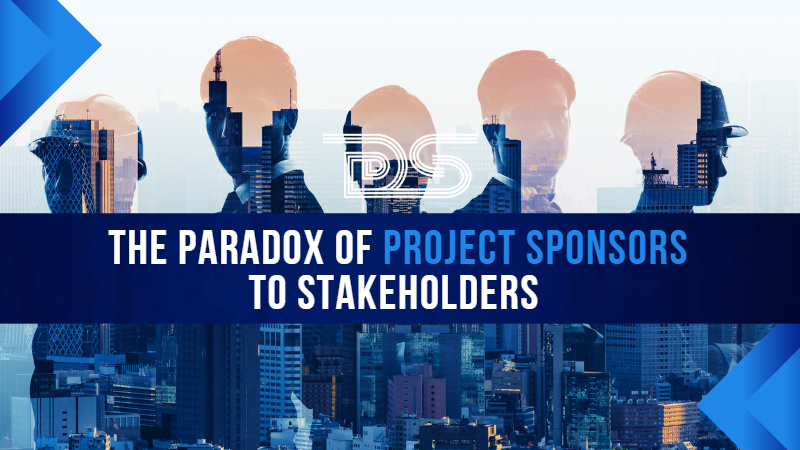
by DharamCW | Mar 10, 2023 | General
A project is deemed successful when it meets or exceeds the expectations of its stakeholders. Every project has a unique set of stakeholders—sometimes far too many. Trying to meet all of their requirements is more often an impossible task. Nonetheless, the project manager must deal with all stakeholder situations smoothly because the stakeholders and the people they represent often evaluate the project’s success.
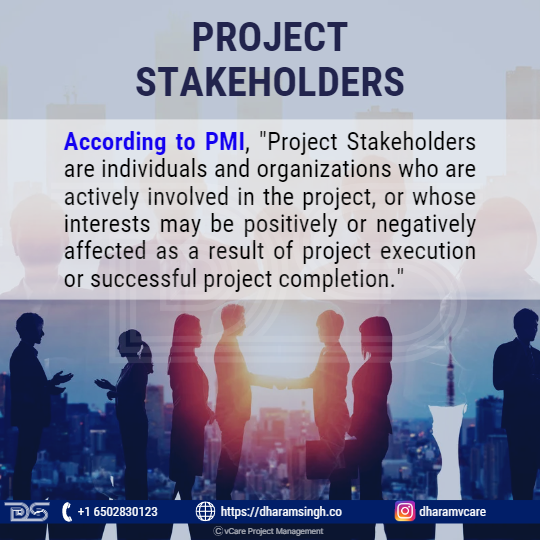
Project Stakeholders
But who are the stakeholders? According to PMI, “Project stakeholders are individuals and organizations who are actively involved in the project, or whose interests may be positively or negatively affected as a result of project execution or successful project completion.”
Stakeholders can be internal or external to the organization that is carrying out the project.
“Project Sponsor” is also a stakeholder, typically an organization executive with authority to assign resources and enforce project decisions. Project sponsors are called internal stakeholders in the project. Stakeholders include the project manager, project team members, and managers from other departments within the organization. Identifying all project stakeholders as early as possible in a project is critical. Leaving out key stakeholders or the department’s function and not discovering the fault until the project is well underway could be disastrous.
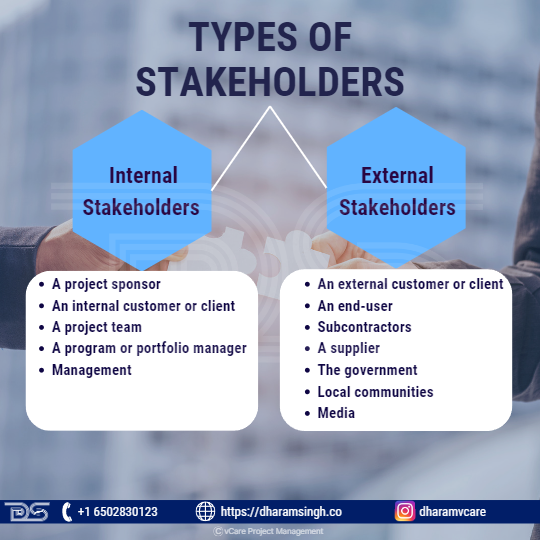
Types of Stakeholders
Types of Stakeholders
There are two types of project stakeholders:
- Internal Stakeholders
- External Stakeholders
Internal stakeholders are individuals or businesses whose relationship with a company is determined by their position within its structure. As the name implies, these individuals are involved in a project from the inside. They are as follows:
- A project sponsor
- An internal customer or client
- A project team
- A program or portfolio manager
- Management
- Another team’s manager of the company
External stakeholders are those interested in a company’s operations. Still, they do not necessarily have a role in the decisions of the business. However, they can influence success or failure based on their vested interests. They can be just as powerful as internal stakeholders. These stakeholders are not directly involved in the project but are affected by its outcome.
- An external customer or client
- An end-user
- Subcontractors
- A supplier
- The government
- Local communities
- Media
Characteristics of Stakeholders in a Project
- When contributing to a project, stakeholders have varying levels of responsibility and authority. This level may change as the project progresses. It can range from one-time contributions to complete project sponsorship.
- Some stakeholders may also actively or passively undermine the project’s success. These stakeholders require the project manager’s attention throughout the project’s life cycle.
- Stakeholder identification is a continuous process throughout the project’s life cycle. Identifying them, understanding their level of impact on a project, and meeting their demands, needs, and expectations are critical to the project’s success.
- Just as they can positively or negatively impact a project’s objectives, stakeholders can perceive a project to have positive or negative outcomes.
- A project manager’s most important role is managing stakeholder expectations, which can be challenging because stakeholders often have different or conflicting goals.
Stakeholder Management
Stakeholder management is the process of organizing, monitoring, and improving relationships with stakeholders. It entails systematically identifying stakeholders, analyzing their needs and expectations, and planning and carrying out various tasks to engage them. In addition, a good stakeholder management process will allow them to coordinate their interactions and evaluate the status and quality of their relationships with various stakeholders.
A critical component of running a successful project is developing and maintaining positive relationships with the affected communities and other stakeholders.
Investing time in identifying and prioritizing stakeholders, as well as assessing their interests, provides a solid foundation on which to build the stakeholder engagement strategy. In addition, good stakeholder management includes ‘business intelligence.
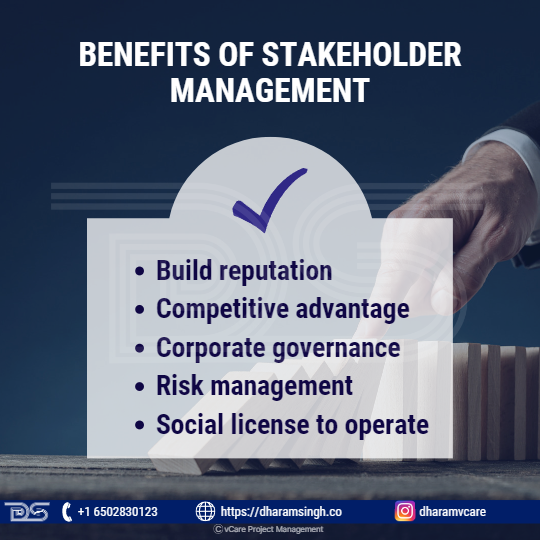
Benefits of Stakeholder Management
Benefits of Stakeholder Management
- Build Reputation
- Competitive advantage
- Corporate governance
- Risk management
- Social license to operate
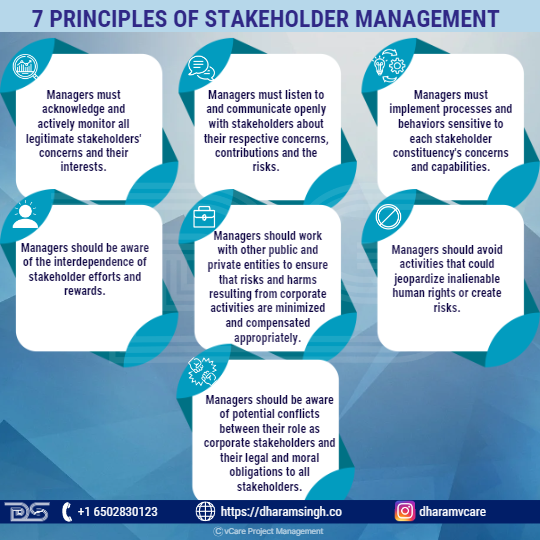
7 Principles of Stakeholder Management
7 Principles of Stakeholder Management
Clarkson Centre created the seven principles of Stakeholder Management for Business Ethics under the leadership of Max Clarkson. The Clarkson Principles are, in many ways, “meta-principles” that encourage management to embrace specific stakeholder principles and implement them according to the norms.
- Managers must acknowledge and actively monitor all legitimate stakeholders’ concerns and consider their interests in decision-making and operations.
- Managers must listen to and communicate openly with stakeholders about their respective concerns and contributions and the risks they face from their involvement with the corporation.
- Managers must implement processes and behaviors sensitive to each stakeholder constituency’s concerns and capabilities.
- Managers should be aware of the interdependence of stakeholder efforts and rewards and make an effort to fairly distribute the costs and benefits of corporate activity among them while taking into account their risks and vulnerabilities.
- Managers should work with other public and private entities to ensure that risks and harms resulting from corporate activities are minimized and compensated appropriately where they cannot be avoided.
- Managers should avoid activities that could jeopardize inalienable human rights or create risks that, if clearly understood, would be patently unacceptable to relevant stakeholders.
- Managers should be aware of potential conflicts between their role as corporate stakeholders and their legal and moral obligations to all stakeholders and address such conflicts through open communication, appropriate reporting and incentive systems, and, if necessary, third-party review.
Understanding the Stakeholders
A good understanding of the stakeholders is the key to successful stakeholder engagement. In addition, understanding stakeholder concerns and interests can lead to product or service ideas that address stakeholder needs while allowing the company to cut costs and maximize value.
1. What else can you learn about stakeholders to better understand their needs, priorities, preferences, and concerns? Consider:
- Demographic data- Ensure to engage with a diverse community and stakeholder groups.
- Social networks- Focus on the important, often undocumented, social connections between stakeholders.
2. Stakeholder Mapping – Stakeholder mapping is the visual process of depicting all stakeholders of a product, project, or idea on a single map. The main advantage of a stakeholder map is that it provides a visual representation of all the people who can have an impact on your project and how they are connected.
3. Salience model – investigate the power, urgency (need for immediate action), and legitimacy (appropriate stakeholders), as well as the interaction or groups of stakeholders that result.
4. Determine stakeholder expectations and compare them to the scope and expectations of the project or organization for which the engagement program is being run. Is there a mismatch in expectations, and how will this be addressed? Consider the following:
- What information do they need from you, how often, and in what format/channel do they want it?
- What is their financial/social/emotional stake in the outcome of the work? Is it favorable or unfavorable?
- What primary motivations will shape their perceptions of your project or organization and their interactions with you?
- What are their current feelings about the organization and project? Is it founded on reliable data?
- Who influences their thoughts, and who are they influenced by?
Ways to deal with common stakeholder problems and challenges
- Stakeholder conflict occurs when different stakeholders have incompatible goals. It causes a “problem” for the company because it can impact its performance and success.
- Conflict necessitates that businesses effectively manage stakeholder interests. Not all stakeholders are strategically important to the company. As a result, businesses must determine which ones should be prioritized.
- Potential problems can be avoided by conducting an upfront analysis of who the stakeholders are and how and when to involve them in the project.
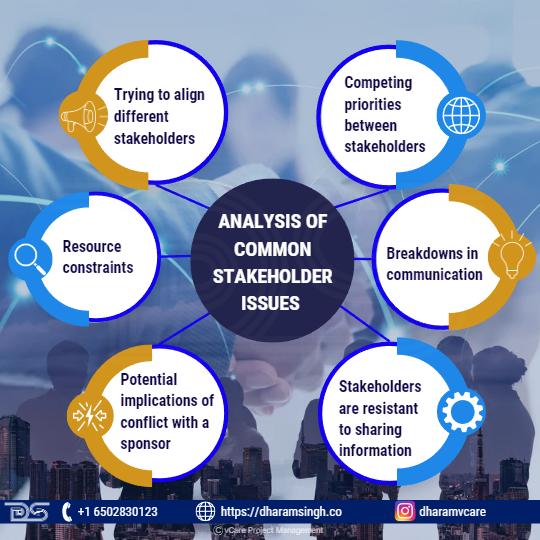
Analysis of common stakeholder issues
Analysis of common stakeholder issues
As no two stakeholders are the same, the issues they may introduce into a project will be vastly different. This factor means there could be many reasons why a project encounters stakeholder resistance or the project team struggles to gain traction. Identifying stakeholder issues during the project can help with planning ahead of time and preparing an appropriate response.
- Trying to align different stakeholders.
It is generally a good thing to have a variety of interests in the project and its outcome, but having a lot of different stakeholders can also pull the project team in too many different directions. In addition, it can be challenging for project managers to coordinate too many different stakeholders, which could add new difficulties to the project.
- Competing priorities between stakeholders
Stakeholders bring their objectives and expectations to the project. However, at least a few of these priorities frequently conflict with or compete with one another. In addition, priorities may vary depending on the department, the role, or the professional backgrounds of the individuals.
- Resource constraints
It’s possible that the team lacks some of the resources they require or that the project is utilizing resources that other stakeholders consider crucial to their projects. Resource competition is common in organizations and can lead to conflict.
- Breakdowns in communication
Effective communication between stakeholders and the project team is crucial for everyone to achieve their objectives and for the project to be successful. When there are communication breakdowns, the project may be delayed, or the team may not receive the necessary information. Without deliberate communication, stakeholders might unintentionally hinder the project’s success.
- Stakeholders are resistant to sharing information.
At times, important project sponsors are more focused on their success and fail to promptly or completely provide the stakeholders with the required information. As a result, stakeholders may attempt to disrupt a project unintentionally or on purpose.
- Potential implications of conflict with a sponsor
Conflict with project sponsors may have many consequences on the project management, such as these typical ones:
- The project’s progress is being slowed
- Reducing the effectiveness and timeliness of decision-making
- Putting team cohesion in jeopardy
- Undermining a project manager’s authority
- Fostering hostility and encouraging uncooperative behavior
- Creating a fearful environment for other stakeholders
- Obscuring the project’s vision
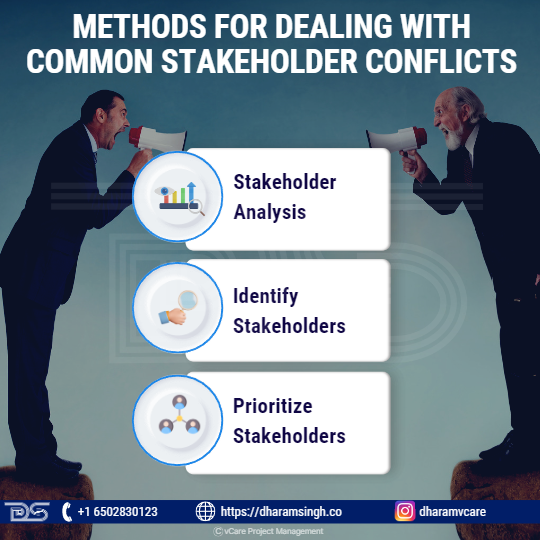
Methods for dealing with common stakeholder conflicts
Methods for dealing with common stakeholder conflicts
- Stakeholder analysis
Stakeholder analysis can offer insightful information and guidance, just as project managers must carefully examine resources and specifics. It can be helpful to respond appropriately by taking the time to consider how stakeholders affect the project’s progress.
By conducting a stakeholder analysis, one can learn how to control expectations, channel stakeholder influence toward project objectives, and deliver the information and updates that stakeholders expect from their team.
- Identify stakeholders
One must first identify the stakeholders to analyze them effectively. List every stakeholder that comes to mind, then include more individuals and organizations as necessary. As stakeholders, all parties involved in the project, those with authority over it or an interest in its success, should be listed.
- Prioritize stakeholders
The list of stakeholders can then be ranked according to impact, interest, and power. For instance:
- Key stakeholders: This first group heavily influences and controls the project. This group is frequently accurate for executive leadership at the company.
- Primary stakeholders: The project immediately affects the key stakeholders. This pack may include team members, departments, and internal or external clients who stand to gain from the project’s outcomes.
- Secondary stakeholders: The secondary stakeholders are those who play a supporting role, are indirectly impacted or have a less significant stake in the project.
Understand the key stakeholders
A few stakeholders are usually critical to the project. Key stakeholders invoke more power and may have a more significant stake in the project’s success than primary or secondary stakeholders. For example, key stakeholders could include their boss, company executives, or team leaders.
Finding the key stakeholders and understanding what they need can help keep the project on track because they may control important resources, have a significant impact on the project, or grant the necessary approval.
Create a communication plan
With a communication plan, project leaders will be better prepared to manage their stakeholders on the fly and keep the project moving forward.
- Create your communication strategy based on what the project leader knows about their stakeholders.
- Keeping track of what the stakeholders require from themselves allows project leaders to stay organized and focused on managing the project.
- Gaining the stakeholders’ trust is essential once the developed strategy has been implemented. Rather than dictating the project to them, make each stakeholder a priority – as appropriate – and give them space to contribute.
Final Thoughts
Different stakeholders in the project have different expectations. Project managers should look for potentially hazardous situations when those expectations might clash. Then, they must address and resolve the conflict or risk endangering the project and themselves.
Resolving stakeholder expectations conflicts is always linked to project success. Furthermore, using various forms of communication among the project team, such as senior management and stakeholders, increases the likelihood of mutual understanding. These techniques help project managers align stakeholder expectations and reduce the possibility of project distress.
Feel free to check out my discussion on this topic with Thomas Walenta in YouTube
For any questions related to your Project Management career, training, and certifications, you can book an obligation free 15 minutes session with me by visiting http://talktodharam.com/
You can subscribe to the vCare Project Management YouTube Channel to catch future videos of our Q&A series and certification success stories: https://bit.ly/2YF0wJl
You can subscribe to and follow my podcasts and interviews with Project Management Experts on YouTube at https://bit.ly/2NDY8wd

by DharamCW | Feb 24, 2023 | General
To be successful in project management, professionals must adhere to specific values like honesty, responsibility, respect, and fairness, which are central to the project management profession and are encompassed by ethics in project management. Therefore, understanding these values and how to apply them is essential for working in project management.
Ethics is important in day-to-day interactions and behaviors in the project management world. “Ethics is about making the best possible decisions concerning people, resources, and the environment,” according to the PMI (Project Management Institute). Ethical decisions can reduce risk, advance positive outcomes, build trust, determine long-term success, and build reputations.
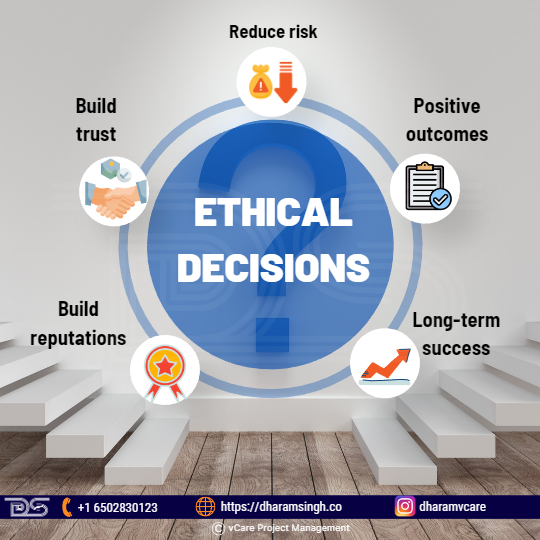
Ethical Decisions
Corporate leaders are responsible for ensuring that their employees practice ethics in the workplace. Failing to follow ethics might result in numerous scandals. The project manager must ensure that all projects are managed and executed efficiently and ethically. If a project manager is ethical, they can influence the project team to work ethically and ensure that all project work is done ethically.
PMI has identified four values for ethical behavior in the project management profession, which can be applied amongst project team members to maintain project loyalty and ethics.
Honesty: Be genuine in your communication and behavior
Responsibility: Take responsibility for your decisions and actions and the consequences that result from them.
Respect: Admire yourself, others, and the resources entrusted to you, such as people, money, and reputation.
Fairness: Decisions and actions should be unbiased, and behavior should be free of favoritism, self-interest, and prejudice.
Therefore, project management professionals must follow the Project Management Institute’s (PMI) Code of Ethics to ensure that all decisions taken are in the best interests of stakeholders and the project team.
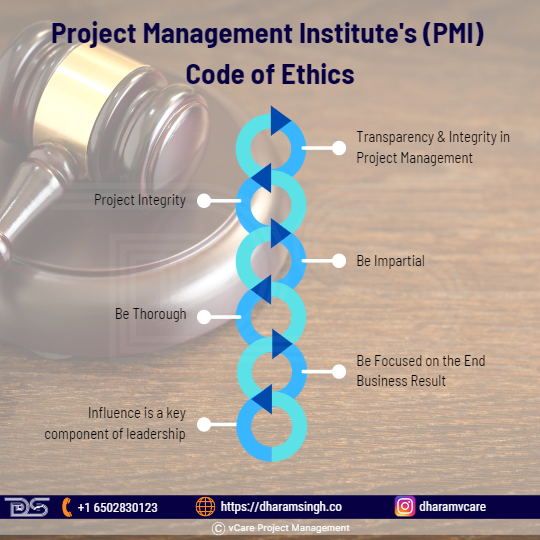
Project Management Institute’s (PMI) Code of Ethics
Transparency & Integrity in Project Management
Project management transparency characterizes a team’s open communication and visibility culture. Information in project management is on a need-to-know basis and is not readily available to everyone. A lack of transparency can lead to resentment or even distrust within the team. Transparency can advance a manager’s career, but it can harm the project manager’s reputation and career if carried out improperly. Therefore, there are many facts to believe that project managers should place a high value on openness and honesty.
The project manager’s transparency can lead to:
- Better performance and accountability
- Eliminates project derailment
- Enhancing teamwork
- Make sure people understand their tasks.
- Communicate openly and explain changes
- Provide and encourage feedback
- Promote knowledge-sharing
- Increase visibility with the right tools
- Focus on project budget
Project Integrity
As a project manager, acting with integrity with other project team members entails being open and honest about their expectations, intentions, and thoughts on their work. In addition, one must have the integrity to make the project team complete the project on time, within budget, and within the project’s scope.
Here are suggestions for acting with integrity with team members:
Be Impartial:
- Be objective and fair.
- Listen to both sides of the tale and different points of view without becoming attached to one in particular due to prejudice or favoritism.
- Rather than patching problems, objective decision-making fleshes them out and allows teams to get to the bottom of them.
Be Thorough:
Complete tasks entirely and thoroughly and validate the steps against a project management methodology of choice. This action ensures that a much more comprehensive project management plan and supporting documentation are created.
Be Focused on the End Business Result:
Regardless of when team members are introduced into the team, they should confirm initial business requirements and the work requested within the scope of their project role. This process enables them to provide their input based on their subject matter expertise, increasing the likelihood of project success.
Influence is a key component of leadership
To influence means to impact other people’s behavior, opinion, and choice. Influence is not the same as power or control. Instead, it is about recognizing what motivates employee commitment and applying that knowledge to boost performance and positive outcomes. The ability to influence others is a necessary leadership trait.
A leader’s ability to influence others is founded on trust; the project manager’s influence grows directly to the level of trust in a relationship. An effective leader motivates team members to act not through coercion but by eliciting their desire and conviction in the leader’s vision and goals. A leader who positively influences others through focused and deliberate effort will gain trust and become a driving force toward excellence.
Let’s look at how leaders can effectively build trust and influence with others.
- Establish credibility
- Engage with team members and build a connection
- Clarify expectations and practice accountability
- Share process knowledge
- Be open to influence
Relationship between stakeholders and project manager to maintain trustworthiness
Communication accounts for up to 90% of a project manager’s job. Conflicts can arise, and projects can fail if there is ineffective communication within the project team. Transparency in the project requires open, two-way communication with stakeholders about the status of a campaign. It keeps clients and stakeholders informed of campaign developments and other project activities.
Why is transparency important for stakeholders?
Transparency is essential in a client-facing project for one simple reason: it fosters trust. When project leader gains the trust of their stakeholders, they are more likely to gain their cooperation and guidance. Maintaining positive stakeholder relationships requires trust, and project stakeholders’ importance cannot be overstated. The support of the stakeholders is critical for project success.
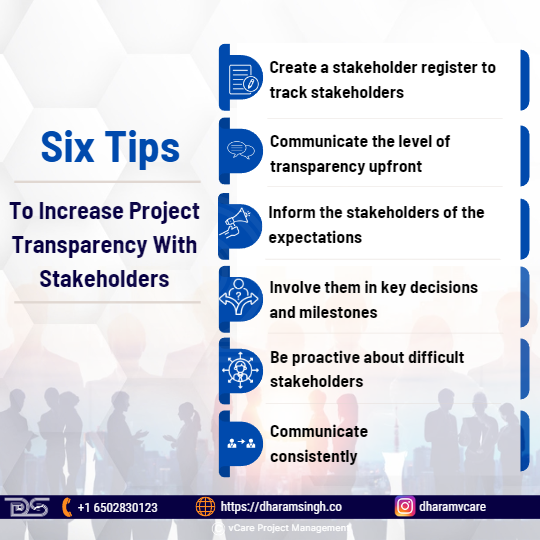
Six Tips To Increase Project Transparency With Stakeholders
Six tips to increase project transparency with stakeholders
- Create a stakeholder register to track stakeholders
- Communicate the level of transparency upfront
- Inform the stakeholders of the expectations.
- Involve them in key decisions and milestones
- Be proactive about difficult stakeholders
- Communicate consistently
Digital Transformation’s Impact on Project Management
Project managers have continued to manage project planning, acquisition, and execution, but their work is evolving with digital transformation.
Most project managers have already incorporated workflow and process automation technology in a few specific areas, like reporting and scheduling. And the majority of them are using digital platforms for project management which can help them stand separate.
How does a project manager acquire the knowledge and experience necessary to lead a digital transformation? What qualities are essential for this type of leader?
PMI’s 2018 Pulse in-depth report ‘Digital PM Skills’ survey conducted by Forrester Consulting for PMI among HR professionals and project managers and identified the top 6 digital-age skills required to get adapted in the digital transformation, like:
- Data science skills
- Innovative mindset
- Security and privacy knowledge
- Legal and regulatory compliance knowledge
- Ability to make data-driven decisions
- Collaborative leadership skills
Cybersecurity’s impact on projects
Project management and the need to establish objectives that protect information security are necessary for today’s project management world. Organizational fragility and vulnerability have increased due to digital transformation, and the proliferation of data and information has become abundant, so it is necessary to safeguard the data from getting misused. Therefore, many businesses are incorporating new elements into their projects to protect their information’s vulnerability, like:
- Security Plan: For the project’s security, a project leader must be aware of the risks to be addressed to develop a security plan. Taking them into account will help them chart the course of the plan and focus on the project’s objectives.
- Business requirements: The project manager must understand the project’s security requirements and business objectives to ensure its completion and success.
- Responsibilities: Each team member should be clear about their responsibilities in terms of security. The well-known RACI (Responsible, Accountable, Consulted, Informed) responsibility assignment matrix is used by many project managers, which aids in ensuring that project objectives are met.
- Security by design: Information security must be considered from the start of a project and throughout the process. Automating processes will improve project success and builds project security.
Pointers to incorporate cybersecurity in project management:
- Determine the project’s sensitive information.
- Evaluate the members’ responsibilities.
- Implement a level of information sensitivity.
- Understand security standards and regulations.
- Include security goals in the project’s objectives.
- Determine the company’s legal responsibilities to the information.
Technology vs. Ethics
Every facet of an organization disrupted by technology shows a possibility of gaining or losing stakeholders’ confidence and commitment. Technology advances can easily outrun the ethical standards that govern their application. Technology’s impact on project ethics is progressing similarly, with employers establishing ethical boundaries that violate employee privacy rights and limit communication abilities.
Some of the technology’s impact on project ethics
- Monitoring Team’s Communications
Project team leaders have monitored employees’ communications during working hours to keep employees focused on work tasks. In addition, because of digital technology and Internet access, there are more chances that project team members can get diverted and utilize the facilities in their personal activities.
The changing definition of the workplace impacts the ethics that underpin the traditional eight-hour work time. It is not ethical simply because technology allows project leader to access their employees and request work at any time. Increasing the working hours to nearly more than their actual hours also blurs the ethical lines in employee compensation.
Employees with restricted access to company property, such as a cell phone or personal computer, may treat it as personal property. An ethical issue may arise when an employee uses office property for non-work-related activities, such as looking for a new job or making personal calls. An employer must establish a clear policy regarding using company property loaned to an employee for business purposes only. This policy enables an employer to develop an ethical standard for using technology.
Ethical Decision Making in Project Management
Decision-making in project management is essentially a great reminder to project success. A truly accomplished project leader inspires, motivates, and builds a strong group that aids their team objectives. The concept of ethical decision-making has also been a focal point in improving project decision-making.
The ethical decision-making process and its roadmap
Every day, a project manager might make thousands of decisions and can come up with the best solution within nanoseconds of hearing about a problem. However, managers must regularly make major decisions incorporating more diligence, forethought, and collaboration with their colleagues. The failure in decision-making can create severe implications and chaos. Thus, organizational performance depends on good decision-making.
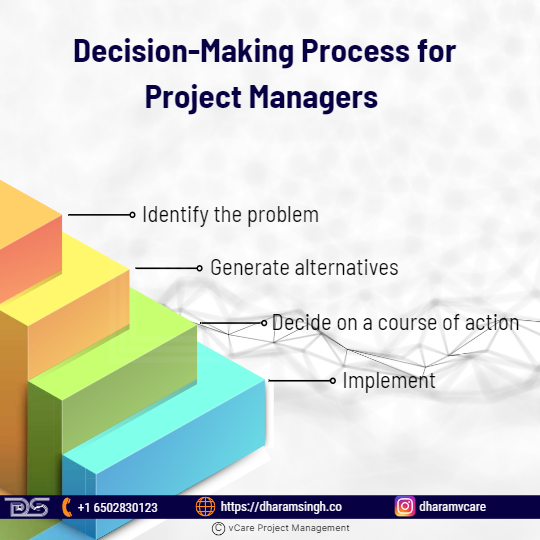
Decision-Making Process for Project Managers
Four steps that can comprise a basic framework for project managers’ decision-making process are:
1) Identify the problem
2) Generate alternatives
3) Decide on a course of action
4) Implement
Ethical Dilemmas in Project Management
The bigger the project, the greater the potential for people or businesses to compromise their moral standards to finish the project on schedule and within budget. The outcomes of project managers and other stakeholders ignoring debatable activity are disastrous, like blown budgets, legal concerns, and even criminal charges, which are too frequent in today’s project environment. Moreover, many businesses are aiming for 100% automation and implementation in the project management process. The project managers need to take charge of these initiatives, which might result in ethical dilemmas involving stakeholders, technology, or communities.
Ethical dilemmas arise when circumstances contradict the project manager’s professional standards or moral values. The project managers must ensure that a project fulfills its social responsibility and well-being commitments by keeping its long-term goals in mind.
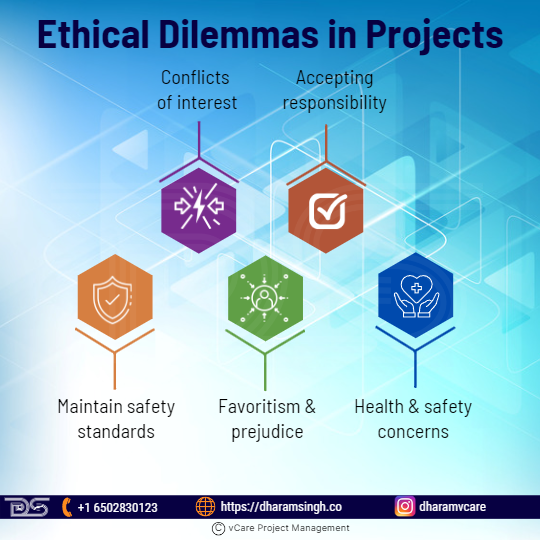
Ethical Dilemmas in Projects
Some Ethical dilemmas in projects include
- Conflicts of interest
For project managers, conflict of interest is a major ethical concern. A conflict of interest occurs only when an individual or group has multiple interests in a project, which may hinder the integrity of the process.
- Accepting responsibility
When a project goes wrong, managers may be tempted to blame workers, supervisors, or vendors for protecting their position. The manager may also consider concealing any evidence that could implicate them in the project’s failure. However, when a project does not go as planned, project managers have an ethical responsibility to accept their failures and start focusing on finding solutions to problems and getting the project back on track.
- Maintain safety standards
Project managers who limit safety standards to save money eventually discover the high costs of not enforcing safety standards with their team. Conversely, a project manager who follows proper safety standards can save a project from incurring costs ranging from minor errors to severe injury or death.
- Favoritism and prejudice
A project leader must not “pick winners” or show bias toward team members. Project managers should choose the participants based on their abilities, not personal preferences. A project manager who shows prejudice toward workers based on race, ethnicity, religion, gender, or other criteria compromises the project’s integrity and exposes the company to a discrimination lawsuit.
- Health and Safety Concerns
Large enterprise projects have high risks and intense deadline pressure. This pressure, unfortunately, can occasionally cause stakeholders to overlook or even hide problems that could endanger the health and safety of project associates or the general public. Although these problems are more likely to occur in the manufacturing, healthcare, or construction sectors, project managers in all sectors should be ready to notify authorities whenever they spot a potentially dangerous situation.
Does project loyalty depend on the individual?
Ethical behavior is essential in all aspects of life, personal and professional. Being an ethical professional benefits everyone, both individually and on a societal and organizational level. Organizations that practice ethics can make their employees optimistic, boost their confidence, and increase their dedication. They can easily draw new clients and consumers due to their honest and ethical behavior, which can significantly improve the project’s sales and profits.
The project manager’s responsibility in Project Management is to manage projects effectively and ethically, as projects are the primary means by which organizations achieve their goals and objectives and develop new services and products. Suppose a new product development project is managed and executed with unethical decisions and actions. In that case, the product will fail to impress and attract customers, resulting in a huge failure and a significant loss in terms of time, project budget, and resources. Customers, clients, and employees value honest and ethical behavior. Thus, a project manager can ideally follow the PMI Code of Ethics and Professional Conduct, which states that they must be honest, respectful, fair, and responsible.
Feel free to check out my discussion on this topic with Thomas Walenta in YouTube
For any questions related to your Project Management career, training, and certifications, you can book an obligation free 15 minutes session with me by visiting http://talktodharam.com/
You can subscribe to the vCare Project Management YouTube Channel to catch future videos of our Q&A series and certification success stories: https://bit.ly/2YF0wJl
You can subscribe to and follow my podcasts and interviews with Project Management Experts on YouTube at https://bit.ly/2NDY8wd
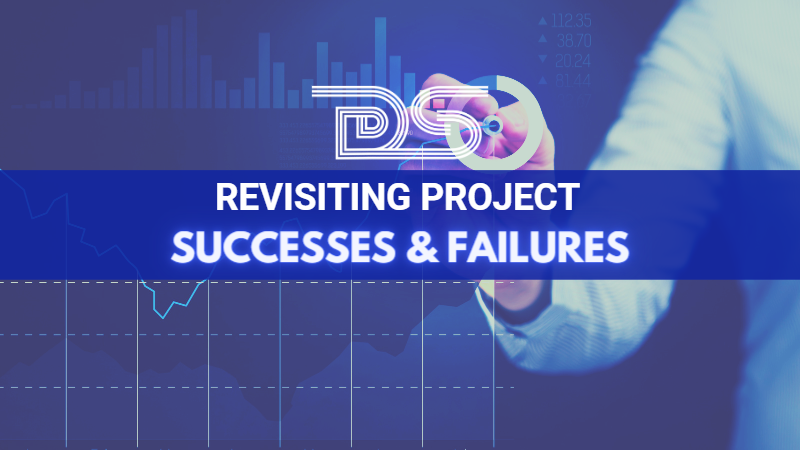
by DharamCW | Jan 15, 2023 | General
A project can be a complex, nonroutine, one-time effort constrained by time, budget, schedule, satisfaction, quality, and scope to meet the customer’s needs. Today, many businesses prioritize project management because it focuses on meeting project objectives and achieving them successfully. Moreover, it got significant because it employs managerial processes and tools that give managers a good chance of achieving their project’s goal.
Project Management Today
Project management has become an essential part of various industrial segments because it crosses corporate and geographic boundaries, adapting to the unique characteristics of various businesses and teams. Here are some of the project trends on the project’s success/ failures.
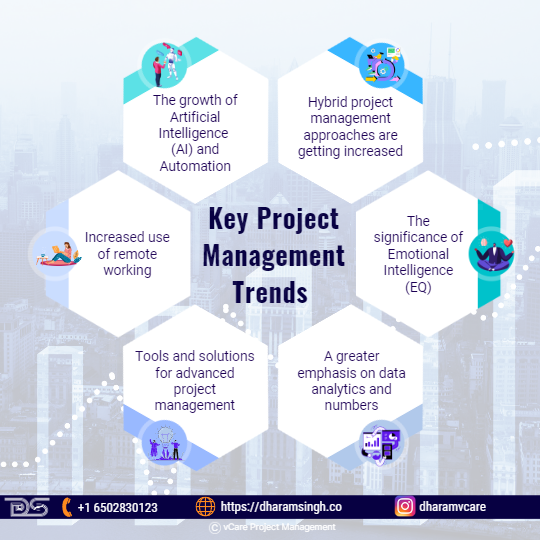
Key Project Management Trends
The Most Important Project Management Trends for 2022
- The growth of Artificial Intelligence (AI) and Automation
- Hybrid project management approaches are getting increased.
- The significance of emotional intelligence (EQ)
- A greater emphasis on data analytics and numbers
- Tools and solutions for advanced project management
- Increased use of remote working
Key Project Management Statistics 2022 (Success and Failures)
Project Success Statistics
- Project management software is used by 77% of high-performing projects. (Hive, 2020)
- 35% of organizations are somewhat satisfied with their project management maturity level. (Wellingtone, 2020)
- 29% of projects are completed on time (Wellingtone, 2020).
- Surprisingly, 54% of organizations lack access to real-time KPIs (Wellingtone, 2020).
- Around 51% of organizations complete projects that meet the business objective or original goal. Meanwhile, 52% of organizations complete projects that meet the needs of stakeholders (KPMG, 2020).
Project Failure Statistics
- COVID-19 had a moderate or significant impact on 58% of organizations, causing project delays and cancellations (KPMG, 2020).
- Organizations with low-value delivery maturity have a project failure rate of 21%, which is significantly higher than the failure rate of organizations with high-value delivery maturity, which is 11% (PMI, 2020).
- 25% of organizations do not use technology suitable for team collaborations on informal projects, despite consuming 20% of their productive time at work (Wellingtone, 2020).
- The most challenging obstacles to implementing agile techniques in an organization are resistance to change (48%), a lack of leadership participation (46%), and inconsistent practices across teams (45%). (Digital.ai, 2020).
- 47% of agile projects are late, have budget overruns, or have dissatisfied customers (Scrum, 2021).
- Understanding these statistics allows project professionals to prepare better for what comes next and make more informed decisions.
Success and Failure of Projects
The business environment is constantly changing, and meeting the customer’s ever-changing needs has become challenging. In addition, customers’ expectations increase as competition in the global market increases. This is sometimes reflected in the pressure that Project Managers face when attempting to provide the best possible value to their customers.
While project management is constantly improving, there are some challenges for which solutions have yet to be found. Global projects are typically getting complex, and as a result, a similar project may be successful in one part of the world while failing in another. Let’s look at the factors for successes and failures on similar projects, as well as how leadership style can help to improve project performance as a contributing factor to the project’s outcome.
Causes of project failure
A project is considered a failure if it fails to deliver on time within the estimated budget. Most project managers have felt the agony of a failed project. In fact, according to a Pulse of the Profession® survey 2021, 12% of projects in an organization failed in the previous year.
When a project is considered a failure?
- First, the project did not meet the expectations.
- The client did not receive the desired deliverable.
- The work was not finished on time.
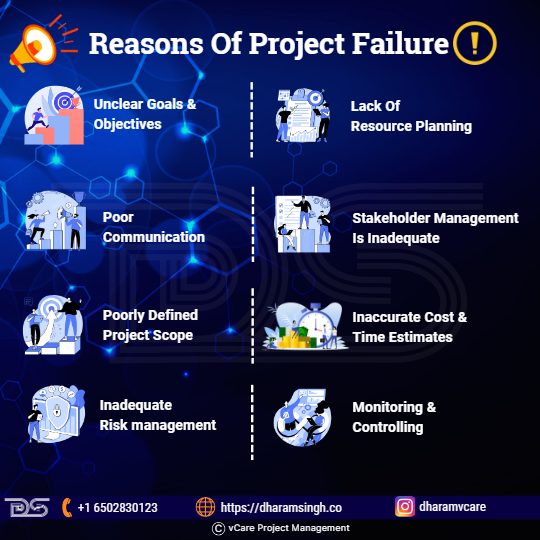
Reasons of Project Failure
So here’s to planning ahead of time and avoiding these common project pitfalls.
- Unclear Goals And Objectives
Businesses that fail to set clear employee goals and objectives waste significant time and effort. The following are the consequences of ambiguous project goals and objectives.
- Unclear objectives lead to ambiguous operational methods.
- Individually, the level of performance can be justified.
- It’s not always obvious when a project deviates from its original path.
- People involved in a project cannot work to their full potential.
- Lack Of Resource Planning
In project management, resources refer to people, money, and materials. Human resources are likely underutilized or overworked if you do not use a good task management tool.
Another critical aspect of project resource planning is financial planning. Projects with poor cost estimation and inconsistent tracking will almost certainly go over budget. In addition, project managers who do not understand how to track and manage finances are more likely to fail the project.
- Poor Communication
Poor communication in the workplace can have disastrous consequences for the project, including poor collaboration and decreased productivity, resulting in stressed employees, dissatisfied customers, and workplace mistrust.
Whether it’s delayed communication, a lack of communication, or no communication at all, the fact is that the project is likely to fall through the cracks if the project professionals don’t have an effective communication strategy in place.
- Stakeholder Management Is Inadequate
Stakeholders have an inherent interest in the project, for better or worse. Project managers are responsible for identifying and communicating with all stakeholders promptly and without delays. Unfortunately, there are numerous reasons for poor stakeholder management, some of which are listed below.
- Stakeholders are too narrowly defined.
- Failure to strike a balance between compliance and strategic opportunities
- Stakeholders are prematurely removing resources.
- Stakeholders’ disinterest
- Stakeholders are unaware of the project’s progress.
Engaged stakeholders provide support and insights to help a project succeed, whereas disengaged stakeholders can become barriers to success.
- Poorly Defined Project Scope
The project scope details everything you intend to do (and not going to do). In project management, scope creep refers to uncontrolled, continuous changes in the scope of a project. Conversely, a poorly defined project scope leads to scope creep, where the former is vaguely defined, documented, or controlled.
A project with an unclear project scope is more likely to fail and encounter a variety of issues, including:
- Failure to meet customer expectations
- Continual changes are being requested throughout the project’s life cycle.
- The budget exceeds the allocated budget.
- Failure to meet deadlines
- Inaccurate Cost And Time Estimates
Inaccurate cost and time estimate frequently result in team members making accurate predictions about the expected duration of tasks and the project’s cost based on an average duration of time and cost for previous projects.
Inaccurate estimates are frequently the result of two underlying causes:
- Upfront planning
- Poor estimation practices
- Inadequate Risk management
Risk management enables project managers to identify and analyze issues that may arise during the project and impede its progress. If risks are not effectively managed, they will likely emerge during the project’s later stages, causing significant scope creep. Conversely, poor risk management can lead to project delays, low user adoption, late assignments, overspent budgets, and project failure.
- Monitoring And Controlling
Monitoring and controlling the project is one of the lesser-known facts that project managers and their teams often overlook. However, a project manager needs to “track, review, and regulate the project’s progress; identify areas that require changes in the planning, and initiate the corresponding changes.”
Every effort should be made to keep the project on track, and if it falls behind budget or schedule, the plan should be adjusted to get the project back on track.
How to Recover a Failing Project?
Three key questions you can ask to quickly and clearly understand the project.
- Are the problems internal or external?
You can determine whether the source of the problem is internal (and thus correctable) or external (outside of your control).
Review project documents such as the charter, plan, and schedule for:
- Requirements from relevant stakeholders.
- A reasonable timetable with attainable goals.
- Allocation of resources
- A method of collecting and managing change requests.
- Unexpected expenses (internal and external).
- Success metrics.
- A procedure for upholding quality standards.
- Why are we behind schedule?
Next, determine why the project is running late.
- Were tasks properly prioritized?
- Were tasks clearly explained?
- Was the timetable overly ambitious?
- How frequently did the project manager provide status updates?
- Who made important project decisions?
- Is there a record of decisions and change requests?
- How were risks communicated and addressed?
- Was the initial budget adequate?
- Is the team working effectively?
Finally, consider how well the team worked together.
- Did the team understand the project’s goal and its roles and responsibilities?
- Was the team using the same procedures and tools?
- Did the team meet regularly to share updates and challenges?
- Was a clear communication strategy in place?
- Were the right people assigned to the project?
- Were there any issues with suppliers or vendors?
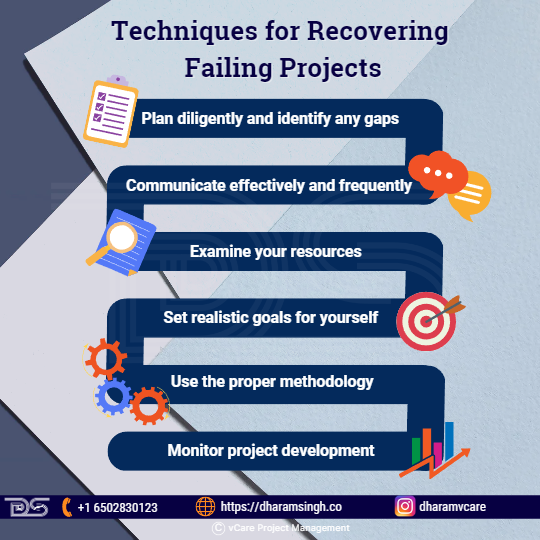
Techniques for Recovering Failing Projects
Techniques for recovering failing projects
While failures are unavoidable in project management, project professionals can always learn from the failures to succeed in the future. So, let’s look at how project managers can ensure that their next project runs smoothly and that any potential problems are identified and resolved before they become too large to cause project failure.
- Plan diligently and identify any gaps.
- Communicate effectively and frequently.
- Examine your Resources
- Set realistic goals for yourself.
- Use the Proper Methodology
- Monitor Project Development
Strategic alignment in project management
Strategic alignment in project management refers to aligning project goals with your organization’s long-term vision and mission.
Contrary to popular belief, strategic alignment in project management does not only refer to establishing and maintaining key financial metrics. Instead, it’s a broad concept that encompasses everything from key financial and quality indicators to customer satisfaction, brand recognition, and value proposition.
Every project has a goal. While some may seek to provide a service or product, others may seek intangible benefits such as positive customer relationships or company goodwill. These strategic goals guide a project professional’s day-to-day business operations and help them turn their ideas into desired results.
Importance of Strategic Alignment in Project Management
- Focus the energy in the right place
- Allow for productive team collaboration
- Describe the organization’s competitive advantages
- Manage priorities that conflict
- Avoid duplication.
- Accept market manoeuvrability
Leadership performance is significant to project success
Effective leadership in project management is the ability to persuade people of the need for change, stimulate new ways of thinking and problem solving, and encourage them to achieve project objectives. Leadership also guides team members to grow as professionals while completing their project responsibilities.
Today’s evidence-based theories of leadership can be characterized into six major classes, which include:
- Attributes
- Behavior
- Contingency
- Visionary
- Emotional intelligence
- Competency
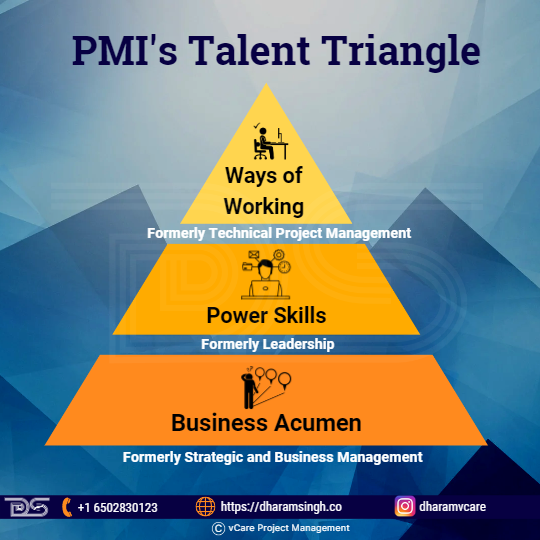
PMI’s Talent Triangle
PMI’s Talent Triangle – How to Stand Out as a Successful Project Manager
Project managers must be more agile and resourceful than ever to keep up with and make an impact in a fast-changing world. PMI has always been dedicated to assisting project professionals in developing strong skills. Nonetheless, project managers now require a skill set that includes a variety of disciplines and practices, as well as other in-demand skills.
To assist project professionals in navigating this changing world of work and embracing smarter ways of working, project professionals need to focus on:
- Ways of Working: Formerly Technical Project Management
- Power Skills: Formerly Leadership
- Business Acumen: Formerly Strategic and Business Management
Factors of project success
Project success has been defined as a project that meets its objectives on time and within budget. A development project’s success extends beyond meeting schedule and budget objectives. It also includes meeting the expectations of beneficiaries, stakeholders, donors, and funding agencies. However, defining these dimensions of success is more complicated and can only be assessed years after the project is completed.
Measuring project success after the fact is important because it aids in determining future strategies when planning new projects. Continuous improvement based on data from past projects enables project managers to identify problems before they occur. Using past data allows new processes to be implemented with fewer errors and greater management success.
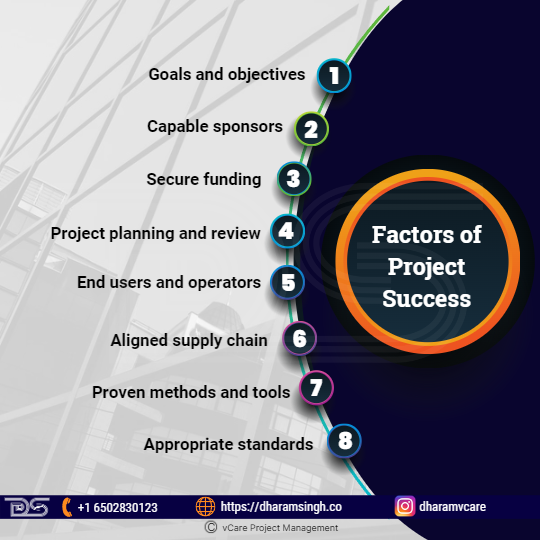
Factors of Project Success
Here are some of the factors for the project’s success:
- Goals and objectives
The project’s overall goal is specified and recognized by all stakeholders; it is not at odds with subsidiary objectives, and project leaders have a clear vision of the project’s outcomes.
- Capable sponsors
Sponsors play an active role in the project’s life cycle; they bear ultimate responsibility and accountability for the project’s outcomes.
- Secure funding
The project has a secure funding base; contingency funding is recognized from the start, and budgets are strictly regulated to ensure maximum value is realized.
- Project planning and review
Pre-project planning is thorough and considered; progress is monitored regularly and carefully; the project has realistic time schedules, active risk management, and a post-project review.
- End users and operators
End users or operators are involved in the project’s design; the project team works with users who can effectively and efficiently implement what the project has produced.
- Aligned supply chain
All direct and indirect suppliers know the project’s requirements, timelines, and quality standards. As a result, the supply chain’s higher and lower tiers are coordinated.
- Proven methods and tools
Good project management tools, methods, and techniques are used to maintain an effective balance of flexibility and robustness.
- Appropriate standards
Quality standards are actively used to drive output quality. In addition, other standards are regularly monitored to ensure delivery at the best practice levels.
Knowing what success factors are important at the end of a project is critical for assessing how that project went and making changes for the next one. It is critical to understand what distinguishes success from failure.
By investing time in learning about the future of project management, project professionals will be better prepared to capitalize on new opportunities and develop their skill set accordingly. So many opportunities for growth and success are on the horizon; use these trends and factors to propel your company, projects, and team to new heights!
Feel free to check out my discussion on this topic with Thomas Walenta in YouTube
For any questions related to your Project Management career, training, and certifications, you can book an obligation free 15 minutes session with me by visiting talktodharam.com
You can subscribe to the vCare Project Management YouTube Channel to catch future videos of our Q&A series and certification success stories: https://bit.ly/2YF0wJl
You can subscribe to and follow my podcasts and interviews with Project Management Experts on YouTube at https://bit.ly/2NDY8wd







































Recent Comments